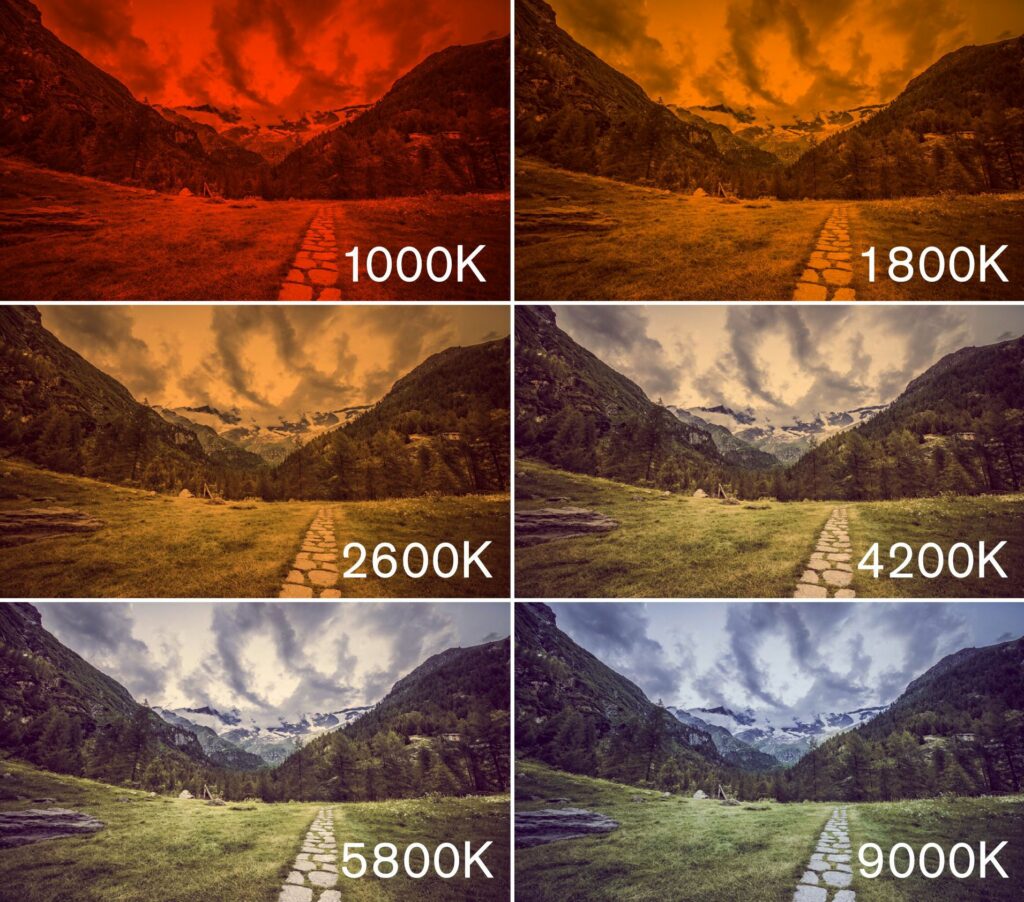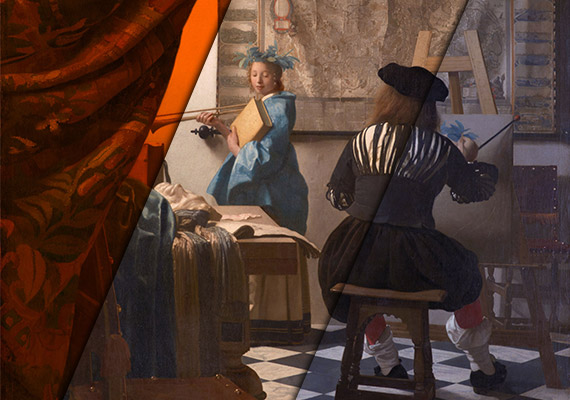For a science project I had to convert a lot of JPG files to different color temperature output files. What I basically wanted was: a folder containing the same image in different color temperature nuances which were also named with the respective Kelvin value. I did some own calculations (thanks to Hernández 1999 at this point!) but came basically to almost the same values like Mitchell Charity in 2001. For all the copycats here: Below you find the values as a convenient python dictionary. Simply copy and paste the thing!
The values as a handy python dictionary
Feel free to copy paste!
kelvin_table = {
1000: (255, 56, 0),
1100: (255, 71, 0),
1200: (255, 83, 0),
1300: (255, 93, 0),
1400: (255, 101, 0),
1500: (255, 109, 0),
1600: (255, 115, 0),
1700: (255, 121, 0),
1800: (255, 126, 0),
1900: (255, 131, 0),
2000: (255, 138, 18),
2100: (255, 142, 33),
2200: (255, 147, 44),
2300: (255, 152, 54),
2400: (255, 157, 63),
2500: (255, 161, 72),
2600: (255, 165, 79),
2700: (255, 169, 87),
2800: (255, 173, 94),
2900: (255, 177, 101),
3000: (255, 180, 107),
3100: (255, 184, 114),
3200: (255, 187, 120),
3300: (255, 190, 126),
3400: (255, 193, 132),
3500: (255, 196, 137),
3600: (255, 199, 143),
3700: (255, 201, 148),
3800: (255, 204, 153),
3900: (255, 206, 159),
4000: (255, 209, 163),
4100: (255, 211, 168),
4200: (255, 213, 173),
4300: (255, 215, 177),
4400: (255, 217, 182),
4500: (255, 219, 186),
4600: (255, 221, 190),
4700: (255, 223, 194),
4800: (255, 225, 198),
4900: (255, 227, 202),
5000: (255, 228, 206),
5100: (255, 230, 210),
5200: (255, 232, 213),
5300: (255, 233, 217),
5400: (255, 235, 220),
5500: (255, 236, 224),
5600: (255, 238, 227),
5700: (255, 239, 230),
5800: (255, 240, 233),
5900: (255, 242, 236),
6000: (255, 243, 239),
6100: (255, 244, 242),
6200: (255, 245, 245),
6300: (255, 246, 247),
6400: (255, 248, 251),
6500: (255, 249, 253),
6600: (254, 249, 255),
6700: (252, 247, 255),
6800: (249, 246, 255),
6900: (247, 245, 255),
7000: (245, 243, 255),
7100: (243, 242, 255),
7200: (240, 241, 255),
7300: (239, 240, 255),
7400: (237, 239, 255),
7500: (235, 238, 255),
7600: (233, 237, 255),
7700: (231, 236, 255),
7800: (230, 235, 255),
7900: (228, 234, 255),
8000: (227, 233, 255),
8100: (225, 232, 255),
8200: (224, 231, 255),
8300: (222, 230, 255),
8400: (221, 230, 255),
8500: (220, 229, 255),
8600: (218, 229, 255),
8700: (217, 227, 255),
8800: (216, 227, 255),
8900: (215, 226, 255),
9000: (214, 225, 255),
9100: (212, 225, 255),
9200: (211, 224, 255),
9300: (210, 223, 255),
9400: (209, 223, 255),
9500: (208, 222, 255),
9600: (207, 221, 255),
9700: (207, 221, 255),
9800: (206, 220, 255),
9900: (205, 220, 255),
10000: (207, 218, 255),
10100: (207, 218, 255),
10200: (206, 217, 255),
10300: (205, 217, 255),
10400: (204, 216, 255),
10500: (204, 216, 255),
10600: (203, 215, 255),
10700: (202, 215, 255),
10800: (202, 214, 255),
10900: (201, 214, 255),
11000: (200, 213, 255),
11100: (200, 213, 255),
11200: (199, 212, 255),
11300: (198, 212, 255),
11400: (198, 212, 255),
11500: (197, 211, 255),
11600: (197, 211, 255),
11700: (197, 210, 255),
11800: (196, 210, 255),
11900: (195, 210, 255),
12000: (195, 209, 255)}The python processing code
All the color transformations were done with a python matrix. After that the image was saved using the PIL library as JPG with the recpective Kelvin value as file name. I am aware that the progressive=False tag will be ignored although I observed that the images get a little larger when this tag is removed. (Don’t ask me why.)
The code is absolutely NOT beautiful, but it does what it has to do.
from PIL import Image
image_path = input("Path: ")
image_save_path = input("Image save path: ")
image = Image.open(image_path)
file_type = '.jpg'// insert here the code from the dictionary above //
kelvin_list = [1000, 1100, 1200, 1300, 1400, 1500, 1600, 1700, 1800, 1900,
2000, 2100, 2200, 2300, 2400, 2500, 2600, 2700, 2800, 2900,
3000, 3100, 3200, 3300, 3400, 3500, 3600, 3700, 3800, 3900,
4000, 4100, 4200, 4300, 4400, 4500, 4600, 4700, 4800, 4900,
5000, 5100, 5200, 5300, 5400, 5500, 5600, 5700, 5800, 5900,
6000, 6100, 6200, 6300, 6400, 6500, 6600, 6700, 6800, 6900,
7000, 7100, 7200, 7300, 7400, 7500, 7600, 7700, 7800, 7900,
8000, 8100, 8200, 8300, 8400, 8500, 8600, 8700, 8800, 8900,
9000, 9100, 9200, 9300, 9400, 9500, 9600, 9700, 9800, 9900,
10000, 10100, 10200, 10300, 10400, 10500, 10600, 10700, 10800, 10900,
11000, 11100, 11200, 11300, 11400, 11500, 11600, 11700, 11800, 11900,
12000]
quality_factor = 2 # higher values means lesser quality. because.
for i in range(0, len(kelvin_list), quality_factor):
kelvin_value = kelvin_list[i]
print('Working on Kelvin value: ', kelvin_value)
temp = kelvin_table[kelvin_value]
r, g, b = temp
color_matrix = (r / 255.0, 0.0, 0.0, 0.0, 0.0, g / 255.0, 0.0, 0.0, 0.0, 0.0, b / 255.0, 0.0)
new_image = image.convert('RGB', color_matrix)
kelvin_list_string = str(kelvin_list[i])
seq = image_save_path + kelvin_list_string + file_type
new_image.save(seq, "JPEG", quality=80, optimize=True, progressive=False)
print('Saving Image: ', seq)Output
The code produces quite nice visual outputs. Have a look at the examples below:


Comments are closed.